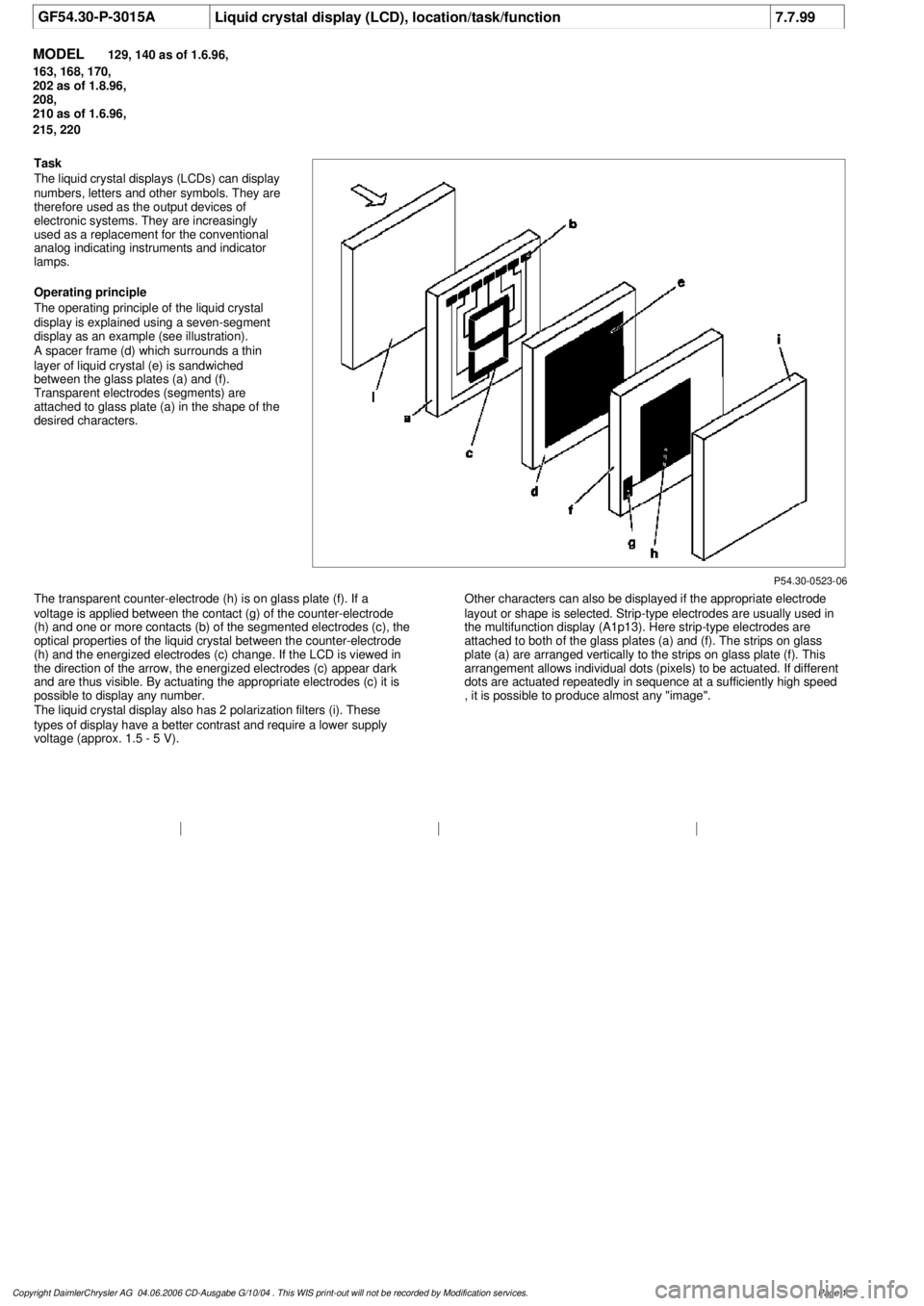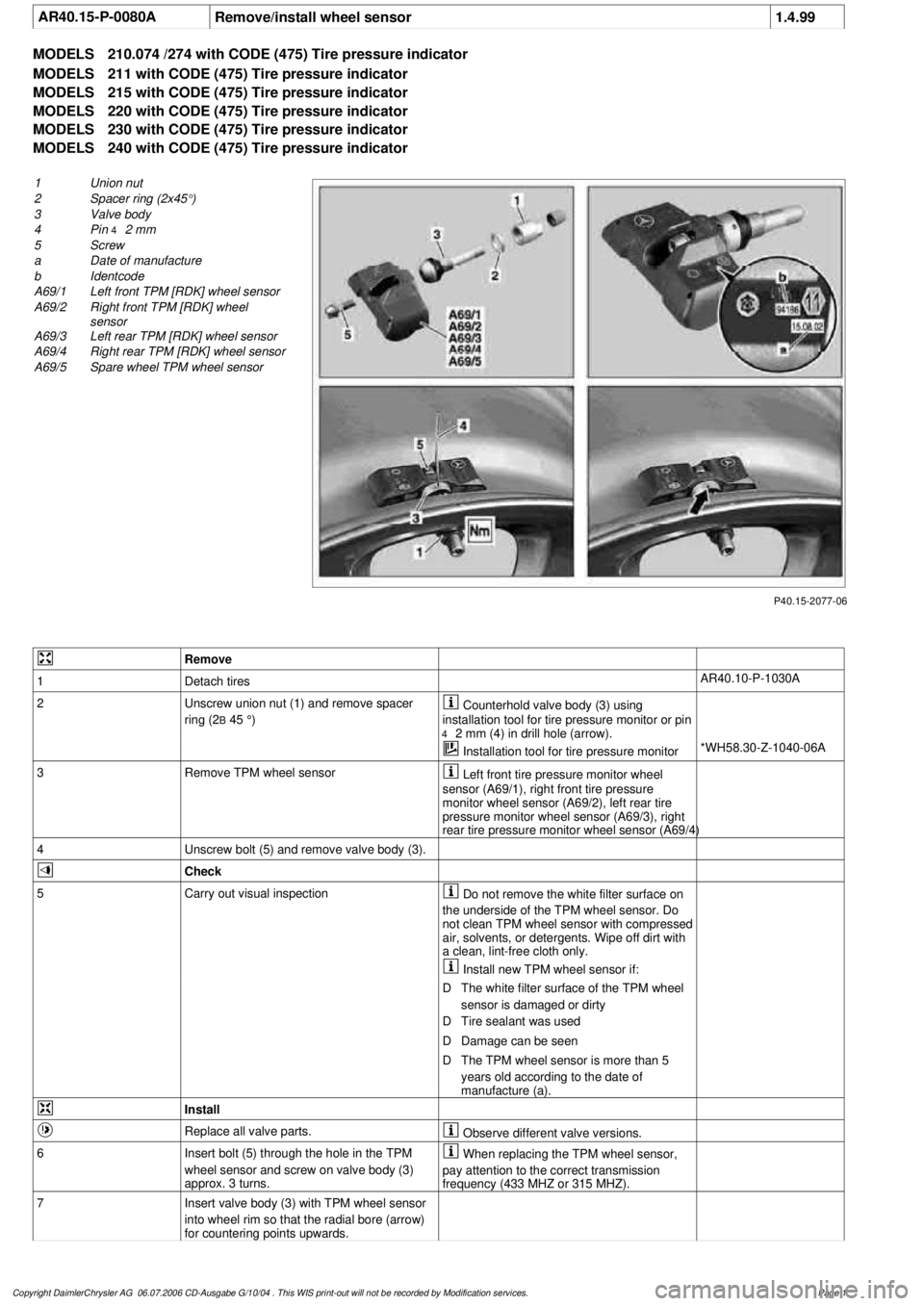1997 MERCEDES-BENZ ML320 service indicator
[x] Cancel search: service indicatorPage 3602 of 4133

GF54.30-P-3015A
Liquid crystal display (LCD), location/task/function
7.7.99
MODEL
129, 140 as of 1.6.96,
163, 168, 170,
202 as of 1.8.96,
208,
210 as of 1.6.96,
215, 220
P54.30-0523-06
Task
The liquid crystal displays (LCDs) can display
numbers, letters and other symbols. They are
therefore used as the output devices of
electronic systems. They are increasingly
used as a replacement for the conventional
analog indicating instruments and indicator
lamps.
Operating principle
The operating principle of the liquid crystal
display is explained using a seven-segment
display as an example (see illustration).
A spacer frame (d) which surrounds a thin
layer of liquid crystal (e) is sandwiched
between the glass plates (a) and (f).
Transparent electrodes (segments) are
attached to glass plate (a) in the shape of the
desired characters.
The transparent counter-electrode (h) is on glass plate (f). If a
voltage is applied between the contact (g) of the counter-electrode
(h) and one or more contacts (b) of the segmented electrodes (c), the
optical properties of the liquid crystal between the counter-electrode
(h) and the energized electrodes (c) change. If the LCD is viewed in
the direction of the arrow, the energized electrodes (c) appear dark
and are thus visible. By actuating the appropriate electrodes (c) it is
possible to display any number.
The liquid crystal display also has 2 polarization filters (i). These
types of display have a better contrast and require a lower supply
voltage (approx. 1.5 - 5 V).
Other characters can also be displayed if the appropriate electrode
layout or shape is selected. Strip-type electrodes are usually used in
the multifunction display (A1p13). Here strip-type electrodes are
attached to both of the glass plates (a) and (f). The strips on glass
plate (a) are arranged vertically to the strips on glass plate (f). This
arrangement allows individual dots (pixels) to be actuated. If different
dots are actuated repeatedly in sequence at a sufficiently high speed
, it is possible to produce almost any "image".
Copyright DaimlerChrysler AG 04.06.2006 CD-Ausgabe G/10/04 . This WIS print-out will not be recorde
d by Modification services.
Page 1
Page 3734 of 4133

GF54.30-P-4104A
Outside temperature display, location/function
8.7.99
MODEL
129
MODEL
140 as of 1.6.96
MODEL
170
MODEL
163, 202 with CODE (240a) Outside temperature display
MODEL
202 as of 1.8.96
MODEL
168
MODEL
208 up to 31.7.99,
210 as of 1.6.96 up to 30.6.99
To display the temperature, the
outside temperature indicator
A1p4
requires:
D
the outside temperature
D
the speed signal
D
the engine running time
and
D
the coolant temperature (model 129, and model 140 as of
1.6.96, model 170, model 202 as of 08/96 and model 163,
model 168, model 210)
The outside temperature is determined by the outside temperature
indicator temperature sensor B14. The temperature sensor is
installed at the front left of the vehicle under the bumper and
connected to the instrument cluster A1 via the 21 or 25-pin
connector, coding part A terminal 1 and 2.
The speed signal, engine running time and engine temperature are
determined internally by the instrument cluster A1.
Since the outside temperature display depends on the speed, engine
running time and coolant temperature, high temperatures (influenced
by the heat generated by the engine, for example) are not displayed
when the vehicle is stationary or moving slowly.
Function, model 202 until 08/95
When the ignition is switched on and off and at speeds below approx.
20 km/h, the last temperature measured is stored and displayed.
If the measured outside temperature drops below the stored value,
the current measured temperature is displayed.
If the outside temperature rises above the stored value, the current
measured outside temperature is displayed only after the following
delays:
D
When the engine is not running, the current outside
temperature is only displayed after 6 times the engine running
time. For example, if the preceding running time was 5 minutes,
the current temperature is not displayed until after 30 minutes.
The maximum delay, however, is 1 hour.
Up to 09.94
D
At vehicle speeds between 20-60 km/h, outside temperatures
are displayed after a delay of approx. 5 min.
D
At vehicle speeds over 60 km/h, outside temperatures are
displayed after a delay of approx. 2 minutes.
As of 09.94
D
At vehicle speeds between 20-45 km/h, outside temperatures
are displayed after a delay of approx. 3 min.
D
At vehicle speeds over 45 km/h, outside temperatures are
displayed after a delay of approx. 1.5 min.
Function
Model 129, model 140 as of 1.6.96, model 170, model 202 as of
08/96, model 163, model 168, model 208 and model 210
D
When the ignition is turned on or off
and with an engine temperature < 60°C
the current temperature is always stored and displayed.
D
When the ignition is turned off
and with an engine temperature < 60°C
the temperature last measured is stored and displayed.
D
When the ignition is turned on
and when an engine temperature < 60(C
The stored temperature is displayed.
If the measured outside temperature drops below the stored value,
the current measured temperature is displayed.
If the outside temperature rises above the stored value, the current
measured outside temperature is displayed only after the following
delays:
D
When the engine is not running, the current outside
temperature is only displayed after 6 times the engine running
time. For example, if the preceding running time was 5 minutes,
the current temperature is not displayed until after 30 minutes.
The maximum delay, however, is 1 hour.
D
At vehicle speeds between 20-45 km/h, outside temperatures
are displayed after a delay of approx. 3 minutes.
D
At vehicle speeds above 45 km/h, outside temperatures are
displayed after a delay of approx. 1.5 minutes.
Copyright DaimlerChrysler AG 05.06.2006 CD-Ausgabe G/10/04 . This WIS print-out will not be recorde
d by Modification services.
Page 1
Page 3833 of 4133

SI91.60-P-0002A
Service information on immobilization of a passenger-side airbag where a
rearward mounted (reboard) child seat is fitted
17.3.99
MODEL
124, 126, 129, 140, 163, 168, 170, 202, 203, 208, 210, 215, 220, 463
Modification notes
18.11.00
Supersedes Service Information SI91.60-P-0002A dated
15.11.00
Remove the SI SI91.60-P-0002A from your file
It is recommended to place the child seat in the rear area if
possible.
If, in exceptional cases, the owner wishes a rearward mounted child
seat to be expressly attached on the front passenger seat, the front
passenger airbag should be immobilized.
As a general rule, there is no approval for immobilizing the front
passenger airbag on models fitted with ACSR, which is visible from
the "airbag OFF" indicator light in the center console. On such
models, an MB child seat with ACSR should be used for safety and
cost reasons.
-----------------------------------------------------------------------------------------
On models fitted with seat belt force limiter, it is essential for
safety reasons to
D
program the front passenger ETR to "NO".
D
unplug the connector at the front passenger ETR.
No provision is made for immobilizing the seat occupied
recognition, the automatic child seat recognition (ACSR), as well as
the side airbag and window airbag.
In the event that it is necessary to immobilize the seat occupied
recognition and automatic child seat recognition (ACSR), for example
if a Recaro seat is installed, this can be carried out in exceptional
cases after agreement has been obtained from GSP/SPS, tel. 07031
/ 90 - 81815.
-----------------------------------------------------------------------------------------
After immobilizing the front passenger airbag or additionally the
ETR, it is essential to
D
have the customer sign the confirmation after immobilization.
D
affix a sticker at a clearly visible point in the area of the front
passenger airbag.
D
affix a sticker in the Owner's Manual, in the section Airbag.
Carry out the remaining procedure as stated below.
-----------------------------------------------------------------------------------------
Deactivation can be reversed at any time.
Immobilization and re-activation must be entered in the
vehicle documents!
The vehicle should be presented in such a case to a technical
inspection center (DEKRA, TÜV). The completed confirmation
should be submitted to the vehicle registration authorities for
entry.
-----------------------------------------------------------------------------------------
Perform version coding / procedure
Model
Version
Coding with HHT
2)
or STAR Diagnosis tool (DAS)
Unplug
connector of
passenger side
airbag
3)
Unplug
connector of
passenger side
emergency
tensioning
retractor
Insert
replacement resistor
3)
Passenger-side
airbag
NO
Passenger side
emergency
tensioning
retractor NO
124
All
--X-X
126
All
--X-X
129
up to 06/93
--X-X
129
as of 07/93 without ACSR
X-X--
140
up to 06/93
--X-X
140
as of 07/93 without ACSR
X-X--
140
as of 07/93 with ACSR
1)
-----
163
up to VIN 145263
--X-X
163
as of VIN 145264
-----
168
All
-----
170
without ACSR
XXXX-
170
with ACSR
1)
-----
202
without seat belt force limiter
X-X--
202
as of 06/97
4)
XXXX-
202
with ACSR
1)
-----
203
All
-----
208
All
-----
210
without ACSR
XXXX-
210
with ACSR
1)
-----
215
All
-----
220
All
-----
Copyright DaimlerChrysler AG 14.06.2006 CD-Ausgabe G/10/04 . This WIS print-out will not be recorde
d by Modification services.
Page 1
Page 3835 of 4133

SI18.00-P-0010A
Service Information: oil sludge
26.3.01
ENGINE
111 in MODELS 124, 163, 170, 202, 203, 208, 210
ENGINE
112 in MODELS 129, 163, 170, 202, 203, 208, 210, 220
ENGINE
112, 113 in MODEL 463
ENGINE
113 in MODELS 129, 163, 202, 208, 210, 215, 220
ENGINE
137 in MODEL 215, 220
ENGINE
166 in MODEL 168
Oil sludging in gasoline engines with ASSYST maintenance
system
Recently we have determined that time and time again oil
sludging occurs in gasoline engines with an ASSYST maintenance
system.
Oil sludging can lead to the following complaints:
D
engine oil consumption
D
engine smoke (white/blue)
D
influencing of oil level indicator
D
clogged oil filter, engine oil thickened like jelly
D
Check engine lamp illuminated
D
oil sludge visible during assembly job, e.g. in oil filter, in cylinder
head covers, condensation sludging
(engine 166) etc.
-----------------------------------------------------------------------------------------
The following list of causes may lead individually or as a combination
to engine oil sludging:
D
Crankcase ventilation inoperable, function orifices, bores,
passages in cylinder head cover, cylinder head, crankcase etc.
are mechanically sealed. A nonfunctioning crankcase
ventilation boosts loads on the engine oil through organic
nitrates. The risk of oil sludging increases.
The mechanical condition of the engine is always to be
checked, i.e. all engine oil drain orifices on the cylinder head
and crankcase and all crankcase ventilation ducts must be free
of obstacles. Crankcase breather lines may not be kinked.
Check the ventilation bores in the cylinder head covers.
-----------------------------------------------------------------------------------------
D
The engine oil used does not comply with the specifications in
Sheet 229.1 or 229.3 of the Specifications for Service Products.
The additive process, e.g. dirt-carrying capability, neutralization
capability and oxidation resistance as well as the quality of the
base stock influence sludging time.
Use of engine oils with best possible resistance to formation of
sludge, i.e. use only tested and approved engine oils (from
Sheet 229.1 or 229.3). The best protection is afforded by the
engine oils on Sheet 229.3, which fulfill more stringent
specifications with regard to preventing sludge and deposits
(see Sheet 221.0, page 11). These oils have a distinctly better
anti-sludge characteristic than other engine oils.
D
Sludging after adding a fuel or engine oil special additive.
Do not use fuel or engine oil special additives. More information
hereto is available on Sheet 219.0 of the Specifications for
Service products. Reference to customer not to use special
additives.
D
Engine oil change not performed according to ASSYST
specifications. At driven distances
exceeding > approx. 3000 km, engine oil sludging may occur.
-----------------------------------------------------------------------------------------
Comply with engine oil and filter change as under ASSYST
specifications. Observe remaining distance.
D
Fuel grade lies outside standard (regionally contingent). If
contaminated, deficient fuel is used, then engine oil sludging
may occur even where approved engine oil is used.
Operation with fuel, e.g. as under DIN EN 228. Clarify refueling
behavior of customer. If engine operation regional, is
temporarily possible with deficient oil only, then the startup
distance has to be individually reduced, i.e. the oil change
temporarily performed at an interval of, e.g. 10,000 km.
D
Radiator antifreeze penetration into engine oil, e.g. through an
internal engine leak (cylinder head gasket, casting porosity).
The engine oil sludges within a short period. The crankcase
ventilation clogs up and stops functioning. Condensation
sludging clogs up the oil separator cells
(engine 166).
Rectify coolant leakage. Clean all sludged engine parts, in
particular the crankcase ventilation parts. If the occurrence
repeats, and casting porosity is suspected, e.g. replace
crankcase.
-----------------------------------------------------------------------------------------
Copyright DaimlerChrysler AG 20.05.2006 CD-Ausgabe G/10/04 . This WIS print-out will not be recorde
d by Modification services.
Page 1
Page 3900 of 4133

5
Remove key and engage steering lock
6
Unscrew bolt (32c)
Hold the steering wheel (32).
Installation:
Replace bolt (32c).
*BA46.10-P-1001-02A
7
Pull off steering wheel (32)
Pass cables carefully through the openings.
Installation:
Align recesses of the splines
in the steering wheel with the markings on the
steering shaft (arrows).
8
Check fanfare horns and airbag clock spring
contact (A45) for damage
The clock spring contact must not be
turned while the steering wheel is removed
otherwise it will be damaged.
Visual inspection, replace clock spring
contact if necessary:
#
Removing and installing clock spring contact
AR46.10-P-0200GH
9
Install in the reverse order
10
Carry out road test
Tests during the road test:
Turn signal canceling:
When the steering wheel is offset by
more than 1 tooth, satisfactory resetting of the
turn signal is no longer guaranteed.
Airbag indicator lamp:
The SRS indicator lamp must not light up
on full steering lock in both directions.
Steering wheel position:
If the steering wheel is crooked, adjust it
by max. 1 tooth. If the difference is greater:
#
Check toe on front axle and adjust if
necessary, see:
#
Performing chassis alignment check
AR40.20-P-0200A
Steering wheel
Number
Designation
Model 163
BA46.10-P-1001-02A
Bolt, steering wheel to steering shaft
Nm
80
Copyright DaimlerChrysler AG 09.05.2006 CD-Ausgabe G/10/04 . This WIS print-out will not be recorde
d by Modification services.
Page 2
Page 3960 of 4133

AD54.30-P-5000-03A
Directly controlled display instruments
troubleshooting chart IC
Directly controlled display instruments or indicator
lamp/warning message:
D
Outside temperature indicator
D
Fuel gauge
D
Oil pressure gauge (models 129 and 140 only)
D
Left turn signal indicator lamp
D
Right turn signal indicator lamp
D
High beam indicator lamp
D
Fuel reserve indicator lamp
D
Airbag SRS indicator lamp/MIL
D
AIRBAG OFF indicator lamp (only model 163 except
I )
D
Low brake fluid level/parking brake indicator lamp (only brake
fluid direct)
(both functions via CAN on model 163)
D
Low windshield washer fluid level indicator lamp (except
models 163 and 168)
D
Low ECL indicator lamp (except models 163 and 168)
D
Generator charge indicator lamp
D
Seat belt reminder lamp
D
Seat belt/backrest lock reminder lamp
D
Exterior lamp failure indicator lamp
D
Hydraulic fluid level indicator lamp (models 202 and 210 only)
D
ADS MIL, suspension
D
Turn signal clicking
D
Seat belt reminder lamp
D
Light reminder lamp
D
Key reminder lamp
D
Soft top reminder lamp (model 170 only)
D
Steering lock warning lamp (
I )
Copyright DaimlerChrysler AG 05.06.2006 CD-Ausgabe G/10/04 . This WIS print-out will not be recorde
d by Modification services.
Page 1
Page 3961 of 4133

AD54.30-P-5000-02A
Display instruments controlled via CAN
troubleshooting chart IC
The following display instruments or indicator lamps/ malfunction
indicator lamps receive their information from the traction system
control module (N47) via CAN data buses (an appropriate message
appears in the display on vehicles with multi-function display):
D
Total mileage recorder, trip odometer
D
Electronic speedometer
D
Low brake fluid level/parking brake indicator lamp (except model 163
parking brake indicator lamp only via CAN)
D
Brake pad wear indicator lamp
D
ABS MIL
D
ETS, ASR, ESP indicator lamp
D
ETS, ASR, ESP malfunction indicator lamp
Model 163 only:
The
"Low-Range"
indicator lamp receives its information from the
transfer case control module (N78) via CAN data buses.
The
"Fog lamps"
indicator lamp (only model 163 except
I
) receives
its information from the All-activity module (AAM, N10) via CAN data
buses.
Model 168 only:
The
" Gear indicator "
indicator lamp receives its information from the
gear recognition module (A61) or from automatic clutch control module
(N15/4) via CAN data buses.
The following display instruments or indicator lamps/
malfunction indicator lamps receive their information from the
injection system control module (N3) via CAN data buses (an
appropriate message appears in the display on vehicles with
multi-function display):
D
Tachometer
D
Low engine oil level lamp
D
Engine coolant temperature
D
Preglow indicator lamp (diesel only)
D
Vehicle speed warning
D
Vehicle speed limit warning
D
Severe leak warning (
I
only), the fuel reserve indicator lamp
(A1e4) flashes
D
Active Service System (ASSYST):
D
Oil condition
D
Oil level
D
Oil temperature
D
Mass volumetric efficiency (load moment)
D
Engine speed, engine coolant temperature
Copyright DaimlerChrysler AG 05.06.2006 CD-Ausgabe G/10/04 . This WIS print-out will not be recorde
d by Modification services.
Page 1
Page 3989 of 4133

AR40.15-P-0080A
Remove/install wheel sensor
1.4.99
MODELS
210.074 /274 with CODE (475) Tire pressure indicator
MODELS
211 with CODE (475) Tire pressure indicator
MODELS
215 with CODE (475) Tire pressure indicator
MODELS
220 with CODE (475) Tire pressure indicator
MODELS
230 with CODE (475) Tire pressure indicator
MODELS
240 with CODE (475) Tire pressure indicator
P40.15-2077-06
1
Union nut
2
Spacer ring (2x45°)
3
Valve body
4
Pin
4
2 mm
5
Screw
a
Date of manufacture
b
Identcode
A69/1
Left front TPM [RDK] wheel sensor
A69/2
Right front TPM [RDK] wheel
sensor
A69/3
Left rear TPM [RDK] wheel sensor
A69/4
Right rear TPM [RDK] wheel sensor
A69/5
Spare wheel TPM wheel sensor
Remove
1
Detach tires
AR40.10-P-1030A
2
Unscrew union nut (1) and remove spacer
ring (2
B
45 °)
Counterhold valve body (3) using
installation tool for tire pressure monitor or pin
4
2 mm (4) in drill hole (arrow).
Installation tool for tire pressure monitor
*WH58.30-Z-1040-06A
3
Remove TPM wheel sensor
Left front tire pressure monitor wheel
sensor (A69/1), right front tire pressure
monitor wheel sensor (A69/2), left rear tire
pressure monitor wheel sensor (A69/3), right
rear tire pressure monitor wheel sensor (A69/4)
4
Unscrew bolt (5) and remove valve body (3).
Check
5
Carry out visual inspection
Do not remove the white filter surface on
the underside of the TPM wheel sensor. Do
not clean TPM wheel sensor with compressed
air, solvents, or detergents. Wipe off dirt with
a clean, lint-free cloth only.
Install new TPM wheel sensor if:
D
The white filter surface of the TPM wheel
sensor is damaged or dirty
D
Tire sealant was used
D
Damage can be seen
D
The TPM wheel sensor is more than 5
years old according to the date of
manufacture (a).
Install
Replace all valve parts.
Observe different valve versions.
6
Insert bolt (5) through the hole in the TPM
wheel sensor and screw on valve body (3)
approx. 3 turns.
When replacing the TPM wheel sensor,
pay attention to the correct transmission
frequency (433 MHZ or 315 MHZ).
7
Insert valve body (3) with TPM wheel sensor
into wheel rim so that the radial bore (arrow)
for countering points upwards.
Copyright DaimlerChrysler AG 06.07.2006 CD-Ausgabe G/10/04 . This WIS print-out will not be recorde
d by Modification services.
Page 1